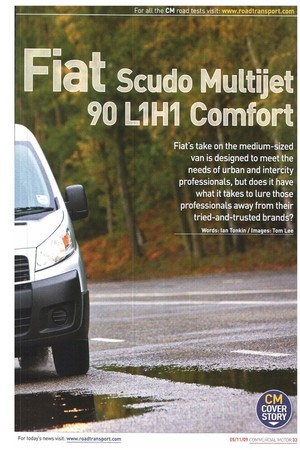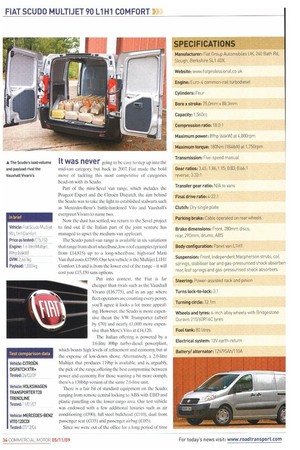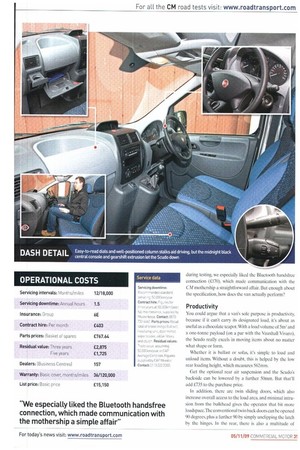Fiat's take on the medium-sized van is designed to meet
Page 33

Page 34

Page 35

Page 36

If you've noticed an error in this article please click here to report it so we can fix it.
the needs of urban and intercity professionals, but does it have what it takes to lure those professionals away from their tried-and-trusted brands?
Words: Ian Tonkin / images: Tom Lee It was never going to be easy to step up into the mid-van category, but back in 2007 Fiat made the bold move of tackling this most competitive of categories head-on with its Scudo.
Part of the mini-Sevel van range, which includes the Peugeot Expert and the Citroen Dispatch, the aim behind the Scudo was to take the fight to established stalwarts such as Mercedes-Benz's battle-hardened Vito and Vauxhall's evergreen Vivaro to name two.
Now the dust has settled, we return to the Sevel project to find out if the Italian part of the joint venture has managed to upset the medium-van applecart, The Scudo panel-van range is available in six variations that range from short wheelbase, low-roof examples (priced from £14,815) up to a long-wheelbase, high-roof Maxi Van that costs £17,995. Our test vehicle is the Multijet LI H Comfort 1.6 and is from the lower end of the range — it will cost you £15,150 sans options.
Put into context, the Fiat is far cheaper than rivals such as the Vauxhall Vivaro (£16,775), and in an age where fleet operators are counting every penny, you'll agree it looks a lot more appealing. However, the Scudo is more expensive thean the VW Transporter (albeit by £70) and nearly £1,000 more expensive than Mere's Vito at £14,120.
The Italian offering is powered by a 1.6-litre 89hp turbo-diesel powerplant, which boasts high levels of refinement and economy, but at the expense of low-down shove. Alternatively, a 2.0-litre Multijet that produces 119hp is available, and is, arguably, the pick of the range, offering the best compromise between power and economy. For those wanting a bit more oomph, there's a 138bhp version of the same 2.0-litre unit.
There is a fair bit of standard equipment on the Scudo, ranging from remote central locking to ABS with EBD and plastic panelling on the lower cargo area. Our test vehicle was endowed with a few additional luxuries such as air conditioning (1590), full steel bulkhead (£110), dual front passenger seat (£135) and passenger airbag (l85).
Since we were out of the office for a long period of time during testing, we especially liked the Bluetooth handsfree connection (E170), which made communication with the CM mothership a straightforward affair. But enough about the specification, how does the van actually perform?
Productivity You could argue that a van's sole purpose is productivity, because if it can't carry its designated load, it's about as useful as a chocolate teapot. With a load volume of 5m3 and a one-tonne payload (on a par with the Vauxhall Vivaro), the Scudo really excels in moving items about no matter what shape or form.
Whether it is ballast or sofas, it's simple to load and unload items. Without a doubt, this is helped by the low rear loading height, which measures 562mm.
Get the optional rear air suspension and the Scudo's backside can be lowered by a further 50mm. But that'll add £735 to the purchase price.
In addition, there are twin sliding doors, which also increase overall access to the load area, and minimal intrusion from the bulkhead gives the operator that bit more loadspace.The conventional twin back doors can be opened 90 degrees, plus a further 90 by simply unclipping the latch by the hinges. In the rear, there is also a multitude of tie-down points — eight to be exact — allowing you the flexibility to fasten any load securely.
With a gross vehicle weight of 2.6 tonnes, plus a further tonne in the back. we were sceptical about the Scudo's prospects on the laden fuel run. Our concerns were over how the engine would handle all that mass, and, after brimming the tank, the Fiat returned 34.1mpg on the 89-mile course. Impressive considering the circumstances.
Unladen. we saw a slight improvement to 39.5mpg, which pips rivals such as the Renault Trafic (33.3mpg and 35.6mpg respectively),but it loses out to the Mercedes-Benz Vito's 38.7mpg (laden) and 40.1mpg (unladen).
Cab comfort
Inspiration is definitely not a watchword when it comes to the interior of the Scudo, with your classic 'grey-on-grey' colour scheme put to use throughout.
However, once you get past the less-than-confident driving position, which has you sat further back than you'd expect due to the Scudo's sloping front end, there's enough positives to keep its head above the proverbial water.
The driver's seat is supportive — the aqua-blue cover fabric injects a bit of colour into the cab — while the range of adjustment, specifically the reach/rake steering wheel, helps to compensate for the low-slung position.
The dials are easy to read and column stalks are well located, while the transmission/gearshift extrusion dents central passenger space more so than many of its rivals. The grade of plastics used may be hardwearing, but they're harsh and stiff to the touch, leaving the Fiat floundering in the 'appeal' category.
However, it still manages to retain an air of practicality thanks to well-thought-out storage options, which include nicely-designed door bins, an overhead parcel shelf, a deep passenger cubby, glovehox and retractable cup holder.
But for all this, the interior still fails to inspire. The sloping windscreen has you feeling hemmed in and reduces visibility, particularly in judging the vehicle's frontal positioning. On the move, there's a fair amount of noise suppression, with the Scudo cruising calmly at speed.
On the road
A small engine and large payload never make particularly good bedfellows, and we feared the Scudo would struggle to lug around a whole tonne of payload.
With just 89hp on tap (plus the weight of the vehicle itself), the Fiat needed lots of encouragement to keep up with traffic, and nipping into gaps or overtaking trucks doing 56mph in the middle lane of the M25 needs to be thought out long in advance.
Despite the 1.6-litre's lack of poke. we were more than satisfied with the Scudo's composure on the uneven roads around south London.The suspension soaks up the bumps and there's sufficient steering feedback, which gives the driver more confidence to manoeuvre around tight turns.
In addition to the standard torsion-beam suspension set-up. there's the option of adding auto-levelling rear pneumatic suspension, which stabilises the vehicle whatever the payload.
While on our Kent van route, we felt the Scudo's brakes lacked feel, and there was always a short l0rnm-20mm gap in travel before we could get the sense of braking through the pedal. However, the brakes were always up to the task, whether it was the very steepest descents or emergency braking for yellow lights. Since the Scudo is a mediumsized van, it'll no doubt spend time out of town on the motorways, and it's here that the Scudo is most at home Getting up to 70mph on the motorway can take longer than the 119hp and 139hp 2.0-litre units, but once there, its happy to plod along without any drama. The five-speed manual box works well with the 1.6-litre engine and feels smooth and rounded rather than rifle-bolt precise, but this suits the Fiat's driving character. •
















































































































































